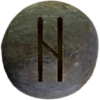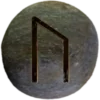Last Updated on October 9, 2024

Níðhöggr (also spelled Nidhogg or Nidhug) is a powerful and malevolent dragon (or serpent). It resides at the base of Yggdrasil, the World Tree, gnawing at its roots. Níðhöggr’s actions symbolize destruction and decay, a force constantly threatening the stability of the cosmos. This constant gnawing represents the relentless decay that challenges the order upheld by the gods.
Níðhöggr is most commonly associated with Helheim, the realm of the dead. It feeds on the corpses of those who have committed grave crimes, especially those who have broken oaths. Níðhöggr also plays a significant role during Ragnarök, the prophesied end of the world. When the final battle concludes, it will rise from the underworld, carrying the bodies of the dead.
While Níðhöggr is an antagonist in the cosmic balance, its existence holds deep meaning in Asatru. It reminds followers of the natural cycles of life, death, and rebirth. The idea that the world can never remain static, and that destruction and decay are inevitable parts of existence, resonates with Asatru practitioners. Níðhöggr embodies the forces of chaos that humanity must endure and overcome.
Níðhöggr’s Importance in Asatru
In Asatru, the figure of Níðhöggr encourages the examination of destructive forces both externally and within oneself. While its presence is associated with death and decay, it also teaches important lessons about resilience. Followers of Asatru often embrace the duality of creation and destruction, and Níðhöggr serves as a powerful symbol of this balance.
Oaths and honor are central to Asatru ethics. Níðhöggr’s role as the devourer of oathbreakers carries significant moral weight in the tradition. Those who break sacred promises face severe consequences in life and death. The threat of Níðhöggr devouring the bodies of oathbreakers acts as a reminder to uphold one’s word, stay true to one’s community, and live honorably.
Although there is no direct Elder Futhark rune explicitly associated with Níðhöggr, the rune Hagalaz (ᚺ) aligns well with the destructive forces it represents. Hagalaz signifies disruption, upheaval, and natural forces beyond human control. It teaches that even though chaos and destruction occur, they pave the way for growth and renewal. For Asatru practitioners, this rune reflects the destructive, yet transformative, aspects of Níðhöggr.
Overall, Níðhöggr’s destructive power is not viewed solely as evil. In Asatru, it symbolizes the cyclical nature of life, where even decay serves a purpose. This deeper understanding of chaos and order strengthens the spiritual path of Asatru practitioners, encouraging them to face life’s hardships with courage and integrity. Níðhöggr, as a symbol of decay, becomes a reminder to honor one’s commitments, face adversity, and grow from challenges.

